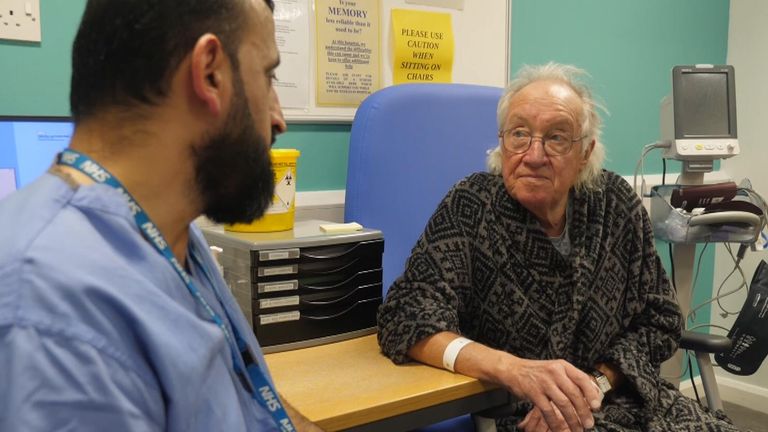An NHS trust in West Yorkshire is exploiting advances in technology, including artificial intelligence and a surgical robot, to help it meet key cancer targets and ease the wider pressure on its hospitals.
Calderdale and Huddersfield NHS Foundation Trust is meeting three key cancer targets set out by the government.
These are a 28-day wait from an urgent referral to a patient being told they have cancer or normal result, a 31-day wait from a decision to treat a patient to when that first treatment takes place, and a 62-day wait from an urgent GP referral to first treatment.
Sky News was invited into Huddersfield Royal Infirmary to see some of the innovations behind those results, starting with a diagnostic test called a Cytosponge.
Essentially a small capsule on a string, the Cytosponge is swallowed by the patient, before the capsule’s coating dissolves in the stomach to release a small brush, which when removed, allows cell collection from the lining of the oesophagus.
These cells are then analysed for any abnormalities.
The Cytosponge is used as an alternative to an endoscopy, which takes longer and is more invasive, a point not lost on Jean Bellenger, who was one of the first patients at the hospital to take the new test, which takes around 15 minutes.
“To be honest with you, endoscopies they’re not right nice,” she said. “But to have this done, this is nothing.”
After Jean gulped down three cups of water, a nurse gently helped coax the sponge down the 72-year-old’s throat, before setting a seven-minute timer.
During that time, Jean could still speak, telling us she was looking forward to having a coffee and some marmalade on toast for breakfast.
The sponge was then taken out of her stomach, sealed and sent away for testing.
Arin Saha, a consultant general surgeon at the hospital, explained how using the Cytosponge is an example of speeding up diagnostics for people like Jean, who have Barrett’s Oesophugus, a condition that means she is more likely to develop gullet cancer.
“You normally get the result back from the lab within a week and you’re able to tell a patient as the result comes back to you,” he said.
“So that’s a really good benefit compared to the old way of doing things when you have to wait for the biopsies that can take a couple of weeks to come back.”
The Cytosponge is not the only tool the trust has brought in to try and identify cancer earlier. It is also using artificial intelligence to review chest X-rays and to help manage the workload of radiographers.
The AI algorithm, known as red dot chest X-ray, assesses chest scans in around seven seconds, meaning patients can receive their results on the same day and begin treatment sooner.
Robot arms used for cyst surgery
Another example of how medics at the hospital are working hand in hand with technology is the use of a surgical robot called Versius, which was introduced earlier this year.
It was initially used for colorectal procedures before being rolled for urology as well.
One patient who arrived expecting to be operated on using Versius was Robert Baume, a 76-year old who was having his kidney removed.
However, in a reminder human judgment still trumps technology, the decision was taken to perform conventional surgery on Mr Baume, to avoid complications that could arise due to two surgeries he’d had before.
Later that day we were shown Versius in action during a procedure to de-roof a cyst. The surgery led by Ali Mustaffa, a consultant surgeon, saw him sit across the room manoeuvring the robot’s arms using the controls at a console with a surgical camera in front of him.
Once set up was complete, the non-invasive, keyhole procedure took around 15 minutes to complete with the robot’s arms using its 360 degree range of motion to full effect.
One of the benefits of using the surgery is that it shortens recovery time for patients, helping to free up bed space.
‘The hospital of the future will have technology ingrained in everything’
Johnny Hammond, the chief operating officer of Calderdale and Huddersfield Trust says meeting cancer targets has been a goal at the hospital “for a number of years”, with incorporating the use of technology a key part of their strategy.
He also added rather than replacing clinical staff, technology is used as a way of streamlining work.
“We have achieved this due to the dedication and hard work of the clinical teams, along with the cancer tracking team and operational and management support,” he said.
“I think the hospital of the future will have technology ingrained in everything that we do.
“I think it’s just making sure that it works well with the clinical teams and also the patient. It needs to free up the time for clinical staff and not necessarily replace staff.”
